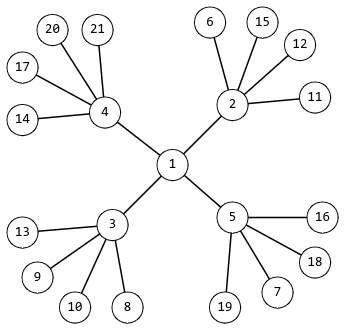| Codeforces Round 883 (Div. 3) |
|---|
| Finished |
This is the hard version of the problem. The only difference is that in this version $$$n \le 10^{18}$$$.
One winter morning, Rudolf was looking thoughtfully out the window, watching the falling snowflakes. He quickly noticed a certain symmetry in the configuration of the snowflakes. And like a true mathematician, Rudolf came up with a mathematical model of a snowflake.
He defined a snowflake as an undirected graph constructed according to the following rules:
- Initially, the graph has only one vertex.
- Then, more vertices are added to the graph. The initial vertex is connected by edges to $$$k$$$ new vertices ($$$k > 1$$$).
- Each vertex that is connected to only one other vertex is connected by edges to $$$k$$$ more new vertices. This step should be done at least once.
The smallest possible snowflake for $$$k = 4$$$ is shown in the figure.

After some mathematical research, Rudolf realized that such snowflakes may not have any number of vertices. Help Rudolf check whether a snowflake with $$$n$$$ vertices can exist.
The first line of the input contains an integer $$$t$$$ ($$$1 \le t \le 10^4$$$) — the number of test cases.
Then follow the descriptions of the test cases.
The first line of each test case contains an integer $$$n$$$ ($$$1 \le n \le 10^{18}$$$) — the number of vertices for which it is necessary to check the existence of a snowflake.
Output $$$t$$$ lines, each of which is the answer to the corresponding test case — "YES" if there exists such $$$k > 1$$$ that a snowflake with the given number of vertices can be constructed; "NO" otherwise.
912361315255101011000000000000000000
NO NO NO NO YES YES YES YES NO
| Name |
|---|




